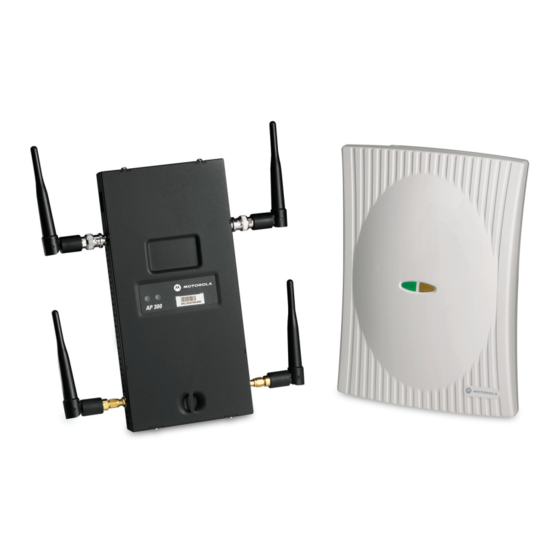
Motorola AP300 - Wireless Access Port Specification Sheet
Plug-n-play 802.11a/b/g access ports
Hide thumbs
Also See for AP300 - Wireless Access Port:
- Reference manual (954 pages) ,
- Specifications manual (114 pages) ,
- Brochure (12 pages)
Advertisement
Quick Links
FEATURES
Mobility
Supports Mobility at
Layer 2 and Layer 3,
working in conjunction
with Motorola's enterprise
wireless LAN switches
Security
This unique dual-function
device can execute and
enforce the IDS/IPS security
policies configured in the
Motorola wireless switch,
and can also be utilized as a
24x7 dedicated sensor with
Wireless IPS from Air Defense
Load balancing,
pre-emptive roaming
and rate scaling
Increases reliability and
resilience of the wireless
network to support mission
critical applications
802.1x supplicant
Allows authentication to
a RADIUS server to enable
an 802.1x-protected
Ethernet port
SPECIFICATION ShEET
AP300 Access Port
Plug-n-play 802.11a/b/g Access Ports:
Securely mobilizing the Wireless Enterprise
More functionality for a fraction
of the cost of access points
Access ports are a key component of Motorola's
award winning wireless switch system, the
wireless LAN architecture that does more, yet
costs less. Working in conjunction with Motorola's
wireless switches, the AP300 Access Port (AP)
delivers robust and feature rich IEEE 802.11a/b/g
connectivity. It can also be used as a sensor in
conjunction with Motorola's Wireless Intrusion
Protection System (IPS). The AP300 can be adopted
as either a Layer 2 or Layer 3 AP, supporting Layer
3 Mobility — substantially reducing the cost of
deploying, implementing and managing a wireless
LAN while significantly increasing features,
functionality and the security of the wireless
LAN infrastructure.
Virtual AP enables true Wireless VLANs for
better device and network performance
With Virtual AP, each access port can support four
separate wireless broadcast domains — functionality
that would otherwise require the installation of four
first-generation access points. These true wireless
VLANs enable separation of mobile end-users,
ensuring that broadcast traffic reaches only those
recipients for whom it is intended. Overall network
traffic is reduced, network and device performance
is improved, and device battery life is increased —
at a fraction of the cost required to deliver the same
functionality in a first generation access point-based
network. Each AP300 supports four BSSIDs (Basic
Service Set Identifiers) and 16 ESSIDs (Extended
Service Set Identifiers) per radio, enabling granular
segmentation of the wireless LAN into multiple
broadcast domains to meet specific enterprise needs.
Typical access points support only one BSSID, utilizing
ESSIDs (instead of BSSIDs) to create wireless VLANs.
Dual-radio 802.11a and 802.11g design
Simultaneous service to 802.11a, 802.11b and
802.11g mobile devices provides high-bandwidth
wireless connectivity at speeds of up to 54 Mbps
in both the 2.4 GHz and 5.2 GHz ISM bands.
Thin AP design
The AP300 requires no configuration or manual
firmware maintenance. The Motorola wireless
switch discovers access ports on the network
and automatically downloads all configuration
parameters and firmware, greatly reducing installation,
maintenance and troubleshooting costs for Layer 2
and Layer 3 deployments.
For more information, visit us on the Web
at www.motorola.com/ap300 or access
our global contact directory at
www.motorola.com/enterprisemobility/contactus
Advertisement

Summary of Contents for Motorola AP300 - Wireless Access Port
- Page 1 FEATURES of the cost of access points functionality in a first generation access point-based Mobility Access ports are a key component of Motorola’s network. Each AP300 supports four BSSIDs (Basic Supports Mobility at award winning wireless switch system, the Service Set Identifiers) and 16 ESSIDs (Extended...
- Page 2 Part number SS-AP300. Printed in USA 11/08. MOTOROLA and the Stylized M Logo are registered in the US Patent & Trademark Office. All other product or service names are the property of their respective owners. ©2008 Motorola, Inc. All rights reserved. For system, product or services availability and specific information within your country, please...















